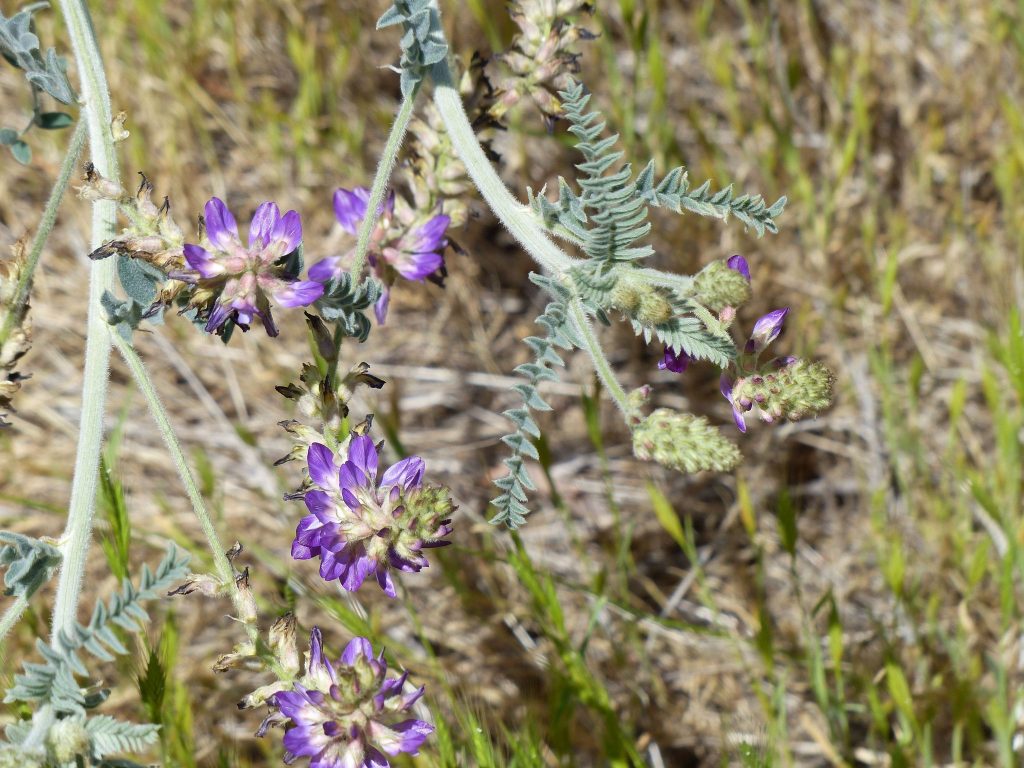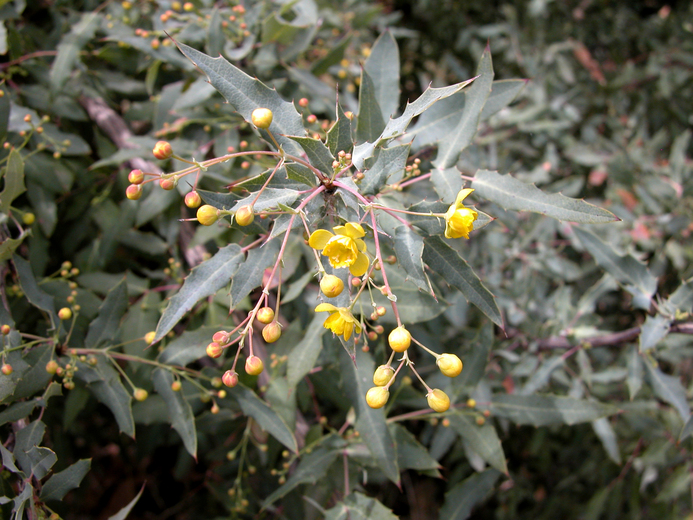To learn more about the plants in the map above, select a species or scroll down.
- Braunton’s milk-vetch
Astragalus brauntonii - Lyon’s pentachaeta
Pentachaeta lyonii - Nevin’s barberry
Berberis nevinii - Thread-leaved brodiaea
Brodiaea filifolia
What is critical habitat?
Critical habitat refers to an area that is believed to be essential to the conservation of a federally endangered or threatened species. The designated area does not necessarily include the species entire range.
Learn more
Braunton’s milk-vetch, Astragalus brauntonii

STATUS
Federal status: Endangered
POPULATION TREND
(+) Improving
RESTORATION
Favorable
FAMILY
Fabaceae, the pea family
RANGE
Endemic to coastal southern California (Ventura, Los Angeles, and Orange Counties)
Appearance
Braunton’s milkvetch is a perennial herb that can grow to 1.5 meters tall. Its stems and pinnately compound leaves are covered in woolly hairs. Its raceme inflorescence features 36 to 60 flowers and blooms from January to August.
Habitat
Braunton’s milkvetch is restricted to carbonate soils of the foothills of the southern California mountains. It occurs in disturbed chaparral, coastal sage scrub, and closed-cone forests and generally occurs along the tops of knolls. Braunton’s milkvetch is a fire-adapted species and post-fire pioneer species that requires an open, light-intensive environment in order to germinate and grow.
Threats
The species’ habitat is primarily threatened by private and urban development. Much of the suitable habitat for Braunton’s milkvetch occurs on privately owned land and is at risk of development.
Conservation
In order to preserve populations in the long-term, Braunton’s milkvetch sites require protection and proper management. The Rancho Santa Ana Botanic Garden also stores Braunton’s milkvetch seeds and studies reliable seed germination and propagation techniques.
Where can you spot it?
Monrovia Wilderness Preserve, Topanga State Park, Chino Hills State Park, Coal Canyon Ecological Reserve, and Santa Monica Mountains National Recreation Area
Back to threatened mainland plants list
Lyon’s pygmydaisy, Pentachaeta lyonii

STATUS
Federal status: Endangered
State status: Endangered
POPULATION TREND
(+) Improving
RESTORATION
Intermediate
FAMILY
Asteraceae, the sunflower family
RANGE
Endemic to southern California, currently found only in Los Angeles and Ventura Counties
Appearance
This annual herb produces small, yellow, daisy-like flowers between April and June. It looks very similar to California gold fields in vegetative form.
Habitat
Lyon’s Pygmydaisy occurs on volcanic rocky clay soils with little disturbance in grassland, coastal sage scrub, and open areas within chaparral. Remaining populations are generally found on saddles, flat areas at the base of slopes, or on top of small hills in a 24 kilometer area of the Santa Monica Mountains.
Threats
The primary threat to Lyon’s Pygmydaisy are habitat degradation, destruction, or fragmentation due to urban development, and competition from non-native invasive species. Frequent fire, which can replace chaparral and coastal scrub communities with non-native grasses, and high-intensity recreation activities such as horseback riding or off-road vehicles can also negatively impact existing populations. The Lyon’s Pygmydaisy populations in Agoura Hills are genetically distinct from the other populations. The majority of currently known occurrences (21 of 30) are on private lands.
Conservation
The U.S. Fish and Wildlife Service recommends controlling populations of non-native invasive grasses, planting individuals in suitable protected areas, working with landowners to protect populations on private property from development, and protecting the species from fire and soil disturbance. Special efforts should be made to preserve the Agoura Hills population at Agora Ranch.
Where can you spot it?
The Pentachaeta Trail in Truinfo Canyon Park
Back to threatened mainland plants list
Nevin’s barberry, Berberis nevinii

STATUS
Federal status: Endangered
State status: Endangered
POPULATION TREND
= Stable
RESTORATION
Favorable
FAMILY
Berberidaceae, the barberry family
RANGE
The Loma Linda Hills, Vail Lake/Oak Mountain region, and San Gabriel Mountain foothills in southern California
Appearance
Nevin’s barberry is an evergreen shrub that ranges in height from 1 to 4 meters tall. It has pinnately compound and serrated, spiny leaves and produces bunches of round berries that range in color from yellow to red. When in bloom between February and April, it displays clusters of yellow, six-petaled flowers.
Habitat
Nevin’s barberry prefers a riparian and alluvial scrub habitat and can be found in foothill woodlands, coastal sage scrub, and chaparral communities. It grows on sandy soils in washes, alluvial terraces, and canyon bottoms.
Threats
Destruction of habitat is the primary threat to this species. The majority of the fourteen known native populations of Nevin’s barberry are threatened by urbanization and recreational activities (e.g. the use of off-road vehicles and horseback riding). One population is also threatened by road widening.
Conservation
Both natural and introduced populations of Nevin’s barberry currently occur in Southern California. Before it was classified as an endangered species, the botanist Theodore Payne collected and propagated Nevin’s Barberry, and it is now sold in nurseries for planting in cultivated landscapes. It is important that native plants continue to be propagated and reintroduced to sites where they historically occurred. It may also be possible to predict sites that will be suitable in the future, based on changing climate conditions.
Where can you spot it?
Individual Nevin’s barberry plants naturally occur at Lopez Canyon and Copal Canyon in Angeles National Forest. Larger populations can be seen at Vail Lake in Riverside.
Back to threatened mainland plants list
Thread-leaved brodiaea, Brodiaea filifolia

STATUS
Federal status: Threatened
State status: Endangered
POPULATION TREND
= Stable
RESTORATION
Intermediate
FAMILY
Themidaceae
RANGE
Southern California, from the foothills of the San Gabriel Mountains in the north to San Diego County in the south
Appearance
Thread-leaved brodiaea is a perennial herb that forms underground bulbs. The leaves are basal and narrow and lily-like in appearance. Its violet flowers bloom from March to June.
Habitat
Thread-leaved brodiaea occurs in native and non-native grasslands, alkali playa, and basalt vernal pools. They are frequently associated with or near vernal pool complexes.
Threats
The primary threat to this species is loss of habitat due to urbanization, illegal grading, and agricultural conversion. Other threats include alteration of hydrology and impacts from livestock grazing, unauthorized off-highway vehicles, and competition from non-native plants.
Conservation
Just 68 occurrences are currently known across Southern California. In Los Angeles County, one of the two known occurrences of thread-leaved brodiaea is permanently conserved by the Glendora Community Conservancy. Protection of the San Dimas/Gordon Highlands populations is required, as they are likely to be impacted by future development.
Where can you spot it?
The Colby Trail on Glendora Community Conservancy land.
Back to threatened mainland plants list
Data source:
Critical habitat from US Fish and Wildlife Service, accessed via ECOS (Environmental Conservation Online System)
References:
- Sclafani (2006). Astragalus brauntonii. In: Fire Effects Information System. U.S. Department of Agriculture, Forest Service, Rocky Mountain Research Station, Fire Sciences Laboratory (Producer). [link]
- Environmental Conservation Online System. Species Profile for Lyon’s pentachaeta (Pentachaeta lyonii). [link]
- Environmental Conservation Online System. Species Profile for Nevin’s barberry (Berberis nevinii). [link]
- Environmental Conservation Online System. Species Profile for Thread-Leaved brodiaea (Brodiaea filifolia). [link]